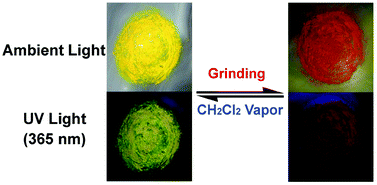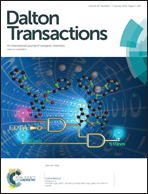Thermo- and mechanical-grinding-triggered color and luminescence switches of the diimine-platinum(ii) complex with 4-bromo-2,2′-bipyridine†
Abstract
The square-planar diimine-platinum(II) complex, Pt(4-Brbpy)(C![[triple bond, length as m-dash]](https://www.rsc.org/images/entities/char_e002.gif) CC6H5)2 (1) (4-Brbpy = 4-bromo-2,2′-bipyridine), was prepared and characterized. Solid-state 1 exhibits reversible thermo- and mechanical-grinding-triggered color and luminescence changes. When crystalline 1·2(CH2Cl2) or 1·2(CHCl3) are heated or ground, the original bright yellow-green emission centered at 525 (549, sh) nm changed to 637 and 690 nm, corresponding to thermo- and mechanochromic response shifts of approximately 88–112 nm and 141–165 nm, respectively. Meanwhile the crystalline state changes into an amorphous phase in both processes. Once the amorphous sample absorbs organic vapors, it can be reverted to the original crystalline state, along with red luminescence turning back to yellow-green emission. The reversibility of thermo- and mechanical-grinding-triggered chromic luminescence properties has been dynamically monitored by emission spectra and X-ray diffraction patterns. The dramatic thermo- and mechanical-grinding-triggered emission red shifts are most likely due to the conversion of the 3MLCT/3LLCT emission state into the 3MMLCT triplet state.
CC6H5)2 (1) (4-Brbpy = 4-bromo-2,2′-bipyridine), was prepared and characterized. Solid-state 1 exhibits reversible thermo- and mechanical-grinding-triggered color and luminescence changes. When crystalline 1·2(CH2Cl2) or 1·2(CHCl3) are heated or ground, the original bright yellow-green emission centered at 525 (549, sh) nm changed to 637 and 690 nm, corresponding to thermo- and mechanochromic response shifts of approximately 88–112 nm and 141–165 nm, respectively. Meanwhile the crystalline state changes into an amorphous phase in both processes. Once the amorphous sample absorbs organic vapors, it can be reverted to the original crystalline state, along with red luminescence turning back to yellow-green emission. The reversibility of thermo- and mechanical-grinding-triggered chromic luminescence properties has been dynamically monitored by emission spectra and X-ray diffraction patterns. The dramatic thermo- and mechanical-grinding-triggered emission red shifts are most likely due to the conversion of the 3MLCT/3LLCT emission state into the 3MMLCT triplet state.


 Please wait while we load your content...
Please wait while we load your content...